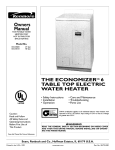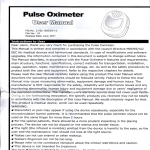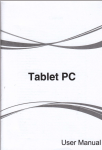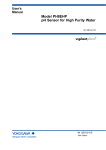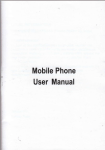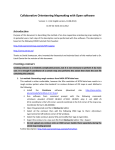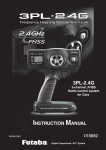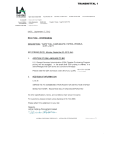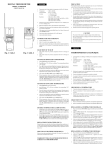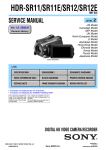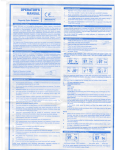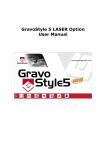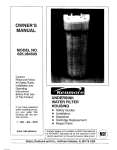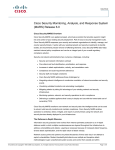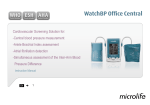Download Pulse Oximeter
Transcript
Pulse Oximeter
Uscr [flamuafl
File No.:2.782.o27ESS/1.3 1401 01
01
7
File Ver: 1.3
Release Date: June. 2011
Dear Users, thank you very much for purchasing our product.
This Manual is written and compiled in accordance with the council directive MDD93/42IEEC
for medical devices and harmonized standards. The Manual is written for the current Pulse
Oximeter. ln case of modifications and software upgrades. the information contained in this
document is sUbject to change without notice.
The Manual describes, in accordance with the Pulse Oximeter's features and requirements,
main structure, functions, specifications, conect methods for transportation, installation,
-sage. operation, repair, maintenance and storage, etc. as well as the safety procedures to
protect both the user and equipment. Refer: to
he respeaive chapters for details.
Please read the Manual very carefully before using this equipment. These instructions
the-operating procedures to'be foilowed strictly, faiiure to follow these instructions
can cause measuring abnormality, equipment damage and personal injury. The manufacturer
is NOT responsible for the safety, reliability and performance issues and any monitoring
aonormality. personal injury and equipment damage due to user's negligence of the operation
instructions. The manufacturer's warranty service does not cover such faults.
Oring to the forthcoming renovation, the specific products you received may not be totally in
accordance with the description of this User Manual. We would sincerely regret for that.
This product is medical device, and can be used repeatedly. lts using life is 3 years.
WARNING:
C:The uncomfortable or painful feeling may appear if using the device ceaselessly, especially
for the microcirculation barrier patients. lt is recommended that the sensor should not be
applied to the same finger for over 2 hours.
5;For the individual patients, there should be a more prudent inspecting in the placing
process. The device can not be clipped on the edema and tender tissue.
CThe light (the infrared is invisible) emitted from the device is harmful to the eyes, so the
user and the maintenance man, can not stare at the light.
$Testee can not use enamel or other makeup.
CTestee's fingernail can not be too long.
C;Please peruse the relative content about the clinical restrictions and caution.
5;This device is not intended for treatment.
1.1 lnstructions for safe operations
FCheck the main unit and all accessories periodically to make sure that there is no visible
damage that may affect patient's safety and monitoring performance about cables and
transducers. lt is recommended thal thg -devlce should be inspected once a w99! at lgast.
When there is obvious damage, stop using the monitor.
>Necessary maintenance must be performed by qualified service engineers ONLY. Users are
not permitted to maintain it by themselves.
FThe oximeter cannot be used together with devices not specified in User's Manual.Only the
accessory that appointed or recommendatory by manufacture can be used with this device.
)This product is calibrated before leaving factory.
1.2 Warnings
FExplosive hazard-DO NOT use the oximeter in environment with inflammable gas such as
some ignitable anesthetic agents.
>DO NOT use the oximeter while the testee measured by MRI and CT'
)The person who is allergic to rubber can not use this device.
)The disposal of scrap instrument and its accessories and packings(including battery plastic
bags, foams and paper boxes) should follolv the local laws and regulations.
Fplease check the packing before use to make sure the device and accessories are totally
in accordance with the packing list, or else the device may have the possibility of working
abnormally.
)please don't measure this device with function test paper for the device's related information.
1.3 Attentions
AKeep the oximeter away from dust, vibration, conosive substances, explosive materials,
high temperature and moisture.
Alf the oximeter gets wet, please stop operating
it,
AWhen it is carried from cold environment to warm or humid environment, please do not use
it immediately.
ADO NOT operate keys on front panel with sharp materials.
AHigh temperature or high pressure steam disinfection of the oximeter is not permitted. Refer
to user Manual in the relative chapter for instructions of cleaning and disinfection.
aDo not have the oximeter immerged in liquid. when it needs cleaning, please wipe its
surface with medical alcohol by soft material. Do not spray any liquid on the device directly.
AWhen cleaning the device with water, the temperature should be lower than 60'C.
AAs to the fingers which are too thin or too mld, it would probably affect the normal measure
of the patients' spo, and pulse rate, please clip the thick finger such as thumb and middle
finger deeply enough into the probe.
ADo not use the device on infant or neonatal patients.
AThe product is suitable for children above four years old and adults (Weight should be
between 15kg to 110k9) .
AThe device may not work for all patients. lf you are unable to achieve stable readings,
discontinue use.
AThe update period of data is less than 5 seconds, which is changeable according to different
individual pulse rate.
aPlease read the measured value when the waveform on screen is equably and steadygoing, This measured value is optimal value. And the waveform at the monment is the
standard one.
Alf some abnormal conditions appear on the screen during test process, pull out the finger
and reinsert to restore normal use.
AThe device has normal useful life for three years since the first electrified use.
AThe hanging rope attached the product is made from Non- allergy material, if particular
group are sensitive to the hanging rope, stop using it. ln addition, pay attention to the use
of the hanging rope., do not wear it around the neck avoiding cause harm to the patient.
AThe instrument dose not have low-voltage alarm function, it only shows the low-
voltage,please change the battery when the battery energy is used out.
AWhen the parameter is particularly, The instrument dose not have alarm function.Do not use
the device in situations where alarms are required.
ABatteries must be removed if the device is going to be stored for more than one month, or
else batteries may leak.
AA flexible circuit connects the two parts of the device. Do not twist or pull on the connection.
The pulse oxygen saturation is the percentage of HbO, in the total Hb in the blood, so-called
the 02concentration in the blood. lt is an important bio-parameterforthe respiration. Forthe
purpose of measuring the SpO, more easily and accurately, our company developed the Pulse
Oximeter. At the same time, the device can measure the pulse rate simultaneously.
The Pulse Oximeter features in small volume, low power consumption, convenient operation
and being portable. It is only necessary for patient to put one of his fingers into a fingertip
photoelectric sensor for diagnosis, and a display screen will directly show measured value of
Hemoglobin Saturation.
2.1 Classification:
Class ll b, (MDD93/42IEEC
lX Rule 10)
2.2 Features
FOperation of the product is simple and convenient.
FThe product is small in volume, light in weight (total weight is about 509 including batteries)
and convenient in carrying.
!Power consumption of the product is low and the two originally equipped
be operated continuously for 20
hours.
AiAA batteries can
\
)The product will automatically be powered off fihen no signal is in the product within
5
seconds.
2.3 Major applications and scope of application
The Pulse Oximeter can be used to measure human Hernoglobin Saturation and pulse rate
through finger, and indicate the pulse intensity by the bardisplay, The product is suitable for
use in family, hospital(Ordinary sickroom), Orygen Bar, social medical organizations and also
the measure of saturation orygen and pulse rate.
I fne product is not suitable for use in continuous supervision for patients.
7\ ffre problem of overrating would emerge when the patient is suffering from toxicosis
which caused by carbon monoxide, the device is not recommended to be used under this
circumstance.
2.4 Environment requirements
Storage Environment
a) Temperature :-40"c ,-+60"c
b) Relative humidity :5%o-95"/o
c) Atmospheric pressure :500hPa-- 1 060hPa
Operating Environment
a) Temperature: 10'c -40'c
b) Relative Humidity'.30o/o -7
5o/o
3-1
ftircipb d
rneasurement
ftfuxipb of the oximeter is as follows: An experience formula
of data process is established
taking use of Lambert Bee.r Law according to Spectrum
Absorption characteristics of
Reduclive Hemogrobin (Hb) and oxynemotrobin (Hbor)
in grow a n""r-intr"r"d zones.
'!2peration principle of tlre- itshument is: Photoele-ctric oxyhemoglobin
lnspection Technology
is adopted in accordance with capacity purse sLnning
a n""oiing r""hnoiogy, so that two
beams-of different wavelength of lights can be focused
onto human nail tip through perspective
clamp finger{ype sensor. Then measured signal can
be obtained by a photosensitive element,
information acquired through which will be shown on
screen through treatment in electronic
circuits and microprocessor.
Glorrand lnfrared*ay
Emission Tube
--'---+
Glmrand
Figure 1 Operating principle
3.2 Caution
l The finger should be placed properly (see the attached illustration of this manual
,Figure 5),
qr else it may cause inaccurate measurement.
|
2.The spo, sensor and photoerectric receiving tube shourd
be arranged in a way with the
I subject's arteriole in a position there between.
3'The Spo, sensor should not be used at a location or
limb tied with arterial canal or blood
pressure cuff or receiving intravenous injection.
4'Make sure the optical path is free from any optical obstacles
like rubberized fabric.
5.Excessive ambient light may affecl the measuring resurt.
rt incrudes fluorescent ramp, duar
ruby light, infrared heater, direct sunlight and etc.
o'Strenuous action of the subject or extreme electrosurgical
interference may alsc affect the
accuracy.
T.Testee can not use enamel or other makeup.
3.3 Clinical reskictions
1-As the measure is taken on the basis of arteriore purse,
substantiar pursating brood
florv of subject is required. For a subject with weak pulse
due to shock, low ambient/body
Hnperature, major breeding, or use of vascurar contracting dnrg,
the
waveform (PLETH)
lill decrease. ln this case, the measurement wiil be more sensitive toSpo,
interference.
2'For those with a substantial amount of staining dilution
drug (sucfr as methylene blue, indigo
green and acid indigo blue), or carbon monoxile hemogklDin
(col-lb), r nrethionine (Me+Hb)
or thiosalicylic hemoglobin, and some with icterus probbrn,
te s@, determination by this
monitor may be inaccurate.
3'The drugs like dopamine, procaine, prilocaine, lidocaine and
butacaine may also be a major
iactor blamed for serious error of SpO, measure.
4As.the spo, value serves as a refdrence value for judgement of
anemic anoxia and toxic
lnoxia, some patients with sgrious anemia may also reoort oood Sno meacr rramon+
lpisplay
Format: OLED Disptay;
SpO, Measuring Range:
Oo/o
-
loOo/o;
Pulse Rate Measuring Range: 30 bpm - 250 bpm;
Pulse Wave Display: columniation display and the waveform
display.
Requirements: 2 x1 .sy AAA arkarine battery(or using the rechargeable
battery
adaptable range: 2.6V-3.6V.
3,Po,,ver Consumption: Smaller than 30mA.
.l Resclution: 1% for SpO, and 1 bpm for Pulse Ra--:
5 l,'easurement Accuracy: t2% in stage of 70::-'lr_': S:,O2. and meaningless when
:E - : s-aller tltan 70o/o. t2 bpm ort2% (select la.3e:':r =- se Rate.
i t,'::s--e.nent Performance in Weak Filling Cc,.,:::- S:O_ and pulse
rrr*3rlr,,,re^:.-.;lse-fillingratiois0.4%.SpO2e-.
--+::=:s=':e'.
s:a-ae :.
:ar ::,: -
s..:rrounding Iight: The
s:l::
stage
rate can be shown
3.iserateerrorist2bpmor+2o/t
devia::- :a:,i,een the value measured in the
:f ra"--a,-re,t-ra'-:c,ornatural lightandthatc,tr=-._-:,:- slessthantl%.
8r rt s eq.ippec rlrr a'urction switch. The oxir,sie:
3€ cowered off in case no finger is
=-
the Oximeter wiihin 5 seconcs.
9) Optical Sensor
Red light (wavelength is 660nm. 6.65mW)
lnfrared
is 880nm. 6
FOne hanging rope;
FTwo batteries (optional);
FOne User Manual.
6.1 View of the front panel
lor-bat tery
ind
ication
lse rate
{.*au.*r,
puise bar
graph pulse
rayeform
Figure 2 Front view
6.2 Battery
Step 1" Refer to Figure 3. and insert the two AAA size batteries properly in the right direction.
Step 2. Replace the cover.
flPlease take care when you insert the batteries for the improper insertion may damage the
device.
r
Figure 3 Batteries installation
',lcuntiag the hanging rope
Step 1. Put the end of the rope through the hole.
Step 2. Put another end of the rope through the first one and then tighten
i
-"
{w
Figure 4 Mounting the hanging rope
it.
irGert.Ire tf,D bateries property to the direction, and then replace the cover
Open SE
db
c
shctYn in Figure 5.
Figure 5 Put finger in position
Let the patient's finger put into the rubber cushions of the clip (make sure the finger is in
the right position), and then clip the
4) Press the switch button once on front
3)
5)
fnger.
panel.
I
I
Do not shake the finger and keep the patient at ease during the process. Meanwhile, I
status.
huma+bodrrisnolrecommenddin
6)
I
movernent
Get the information directly from screen display.
button 0-t5 has three functions.When the device is power off, pressing the button
can open it; When the device is power on, pressing the button shortly can change direction of
the screen; When the device is power on, pressing the button long can change brightness of
7) fhe
I
I
I
i
and the luminescent tube should be on the same side.
)
F
F
>
)
Please change the batteries when the low-voltage displayed on the screen.
Please clean the surface of the device before using. Wipe the device with medical alcohol
first, and then let it dry in air or clean it by dry clean fabric.
Using the medical alcohol to disinfect the product after use, prevent from cross infection for
next time use.
Please take out the batteries if the oximeter is not in use for a long time.
The best storage environment of the device is - 40oC to 60oC ambient temperature and not
higher than 95% relative humidity.
lvlt
lvlrvYv
ulgHlg,vv
The device needs to be calibrated once a year (or according to the calibrating program of
hospital). lt also can be performed at the state-appointed agent or just contact us for
I
I
A
calibration.
High-pressure sterilization cannot be used on the device.
Do not immerse the device in liquid.
tt is recommended that the device should be kept in a dry environment. Humidity may
reduce the useful life of the device, or even damage
it.
]
I
Trouble :
Possible
Reassr
i
Solution
: 1. Place the
The SpO, and
Pulse Rate can
not be displayed
normally
finger properly
1. The finger is not properly positioned. i and try again.
2. The patient's SpO, is too low to
2. Try again; Go to a hospital
: for a diagnosis if you are sure
be
detected.
,l!" o9v!c9 wgfs 3!llishl:
l Place the finger properly
r:;:iJfl,1Tlien,.eep carm
1. The finger is not placed nside deep
The SpO, and
Pulse Rate are not
2. rhe finser is shaking or rhe patient
dlsplayed stably
moving
enough.
The device can
not be turned on
1. The batteries are drained or almost
drained.
2. The batteries are not inserted
properly.
3. The malfunction of the device.
The display is off
suddenly
r in" a"ri." *irr po*"r
i1
" -'
when it gets no signal within 5 seconds.
:' change
-- ,: 2'
^i
batteries'
2. The batteries are almost dr-aiJ
,-.'-
:Warning
o-t:\
-
A
E
IPXl
See User Manual
pulse oxygen saturation(Y1)
Pufse rate (bpm)
,The battery voltage indication is deficient (change the battery in time
the inexact measule)
iavoidlng
, 1. No finger inselted
2,An lndicator ol signaf
inadequacy
BatteV Oositlve electrode
,
cathode
,Battery
,
l.Power switch
,
2.Change direction of the screen
.3,Change
SN
,
,The
,
1
;;;;;;
Type BF
PRbpm
il
,
6'escription
E
SSp0z
2. Reinstall batteries.
3. Please contact the local
: service center.
:
"rrrt;;ii;;itt
Symbol
A
i 1. Change batteries.
,
brightness of the screen
Serial number
.nlarm inninit
i
.WEEE (2002/96/EC)
:
,
lngress of liquids rank
Display Mode
Display lnformation
The Pulse
Oxygen
oLED
:
eu]se
Pulse
Pufse
naleienl
Inlensltv
wave
io-LED
lua1;oranrrl , oleo
lar;o1anh
disolay
O_LED
i
SpO, Parameter Specification
Measurlns
fuls"
Acclracy
Optical
Sensor
(the resolullon
.or.:-lo0Yo,
:70Yo-100%;
1s
tv"l
.
.
:
, ReO
,.
707o unsOec]fled
+zo/o
,aellow
tigf,t (wavelength is 660nm)
-
Pulse Parameter SPecification
Measuf ng
range
30bOm-250bpm (the
,
lsolution
1 bRmJ
1s
Pulse lntensity
Range
:
Continuous bar-graph display, the higher display indicate
i
the stronger pulse.
Battery Requirement
1.5V (AAA size) alkaline batteries x 2 or rechargeable battery
Battery Useful Life
Two batteries can work continually for 20 hours
Dimensions and Weight
Dimensions
57(L) x 3111ry;
Weight
About 509 (with the batteries)
"
32(H) mm








